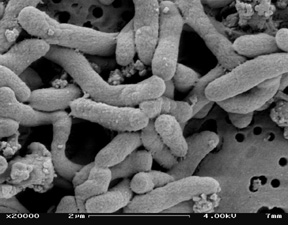Rationale for sequencing the genome of Pseudoalteromonas atlantica T6c: Pseudoalteromonas atlantica is a motile, biofilm-forming, Gram-negative chemoorganotroph that is found in oceans worldwide. This agarase-producing bacterium, first isolated in association with marine algae and named Pseudomonas atlantica (Yaphe 1957), is now assigned to a new genus, Pseudoalteromonas, along with a number of Alteromonas species, based on sequencing of 16S rRNA genes (Gauthier, Gauthier et al. 1995). Like most of the Pseudoalteromonas species, P. atlantica is found associated with marine eukaryotic hosts (seaweed, crab) (Yaphe 1957; Costa-Ramos and Rowley 2004) as well as in the water column (Corpe 1973; Pernthaler, Pernthaler et al. 2001) , and produces a variety of biologically active extracellular compounds (Holmstrom and Kjelleberg 1999). These compounds often influence succession in marine communities; for example, several Pseudoalteromonas species produce antibacterial, antifungal, antiviral and/or algicidal molecules while others produce compounds, such as extracellular polysaccharide, that facilitate settlement of tunicate and oyster larvae (Holmstrom and Kjelleberg 1999) . The extracellular compounds identified from P. atlantica include enzymes that hydrolyze agar, alginate, and carrageenan (Akagawa-Matsushita 1992) , acidic extracellular polysaccharide (EPS) (Corpe 1973; Uhlinger and White 1983) , signaling molecules (homoserine lactones; A. Karls, unpublished data), and proteases (Hoffman and Decho 2000) . In biofouling studies performed in the San Diego Bay and in the open ocean off the coasts of California, New Jersey, and Florida, P. atlantica was shown to be a primary biofilm-forming bacteria, attaching to sterile slides and producing voluminous amounts of EPS. Following biofilm formation by P. atlantica , stalked and/or filamentous bacteria with more limited nutrient utilization capabilities attached to the surface, and these organisms were followed by diatoms, microalgae, and sessile protozoa (Corpe 1973) . These results suggest that P. atlantica colonizes solid surfaces quickly, utilizing substrates that are processed for uptake by its secreted agarases, proteases, etc., and then forms biofilms in which the EPS concentrates nutrients and provides substrates for other marine microorganisms. In pelagic samples from the North Sea and in mixed batch cultures, P. atlantica exhibits a short growth delay upon the addition of growth substrates (<12 hours); it predominates in the cultures until approximately 48 hours when other bacteria overtake P. atlantica for total cell mass per ml culture (Pernthaler, Pernthaler et al. 2001). These properties of P. atlantica suggest that it is a pioneer colonist in different marine habitats and therefore it is of great interest to understand its potential in element recycling, materials production, etc., which would be revealed by the genome sequence. The function and regulation of EPS production in P. atlantica biofilms emphasize the importance of sequencing the genome of this marine organism. P. atlantica biofilms have been shown to absorb 20 to 40% of trace metal lead, at a concentration of 10 -6 mol/liter in the growth media, in specialized bioreactor studies (Hsieh, Lion et al. 1985) , and thus may play a role in controlling toxic metal concentrations in marine environments. EPS production is controlled by an unusual DNA recombination system involving reversible insertion of the mobile element IS 492 at an essential eps site; the phase variable expression of EPS appears to responsive to environmental conditions (Bartlett 1988; Perkins-Balding, Duval-Valentin et al. 1999). References: Akagawa-Matsushita, M., Matsuo, M., Koga, Y., and Yamasato, K. (1992). " Alteromonas atlantica sp. nov. and Alteromonas carrageenovora sp. nov., bacteria that decompose algal polysaccharides." Int J Syst Bacteriol 42 (4): 621-627. Bartlett, D. H., Wright, M.E., and Silverman, M. (1988). "Variable expression of extracellular polysaccharide in the marine bacterium Pseudomonas atlantica is controlled by genome rearrangement." Proc Natl Acad Sci U S A 85 : 3923-3927. Corpe, W. A. (1973). Microfouling: The role of primary film forming marine bacteria. Third International Congress on Marine Corrosion and Fouling . R. F. Acker, Brown, B.F., DePalma, J.R., and Iverson, W.P. Evanston, Ill, Northwestern U.P. : 598-609. Costa-Ramos, C. and A. F. Rowley (2004). "Effect of extracellular products of Pseudoalteromonas atlantica on the edible crab Cancer pagurus ." Appl Environ Microbiol 70 (2): 729-35. Gauthier, G., M. Gauthier, et al. (1995). "Phylogenetic analysis of the genera Alteromonas, Shewanella , and Moritella using genes coding for small-subunit rRNA sequences and division of the genus Alteromonas into two genera, Alteromonas (emended) and Pseudoalteromonas gen. nov., and proposal of twelve new species combinations." Int J Syst Bacteriol 45 (4): 755-61. Hoffman, M. and A. W. Decho (2000). "Proteolytic enzymes in the marine bacterium Pseudoalteromonas atlantica : post-secretional activation and effects of environmental conditions." Aquatic Microbial Ecology 23 : 29-39. Holmstrom, C. and S. Kjelleberg (1999). "Marine Pseudoalteromonas species are associated with higher organisms and produce biologically active extracellular agents." FEMS Microbiol Ecol 30 (4): 285-293. Hsieh, K. M., L. W. Lion, et al. (1985). "Bioreactor for the study of defined interactions of toxic metals and biofilms." Appl Environ Microbiol 50 (5): 1155-61. Perkins-Balding, D., G. Duval-Valentin, et al. (1999). "Excision of IS 492 requires flanking target sequences and results in circle formation in Pseudoalteromonas atlantica ." J Bacteriol 181 (16): 4937-48. Pernthaler, A., J. Pernthaler, et al. (2001). "Growth patterns of two marine isolates: adaptations to substrate patchiness?" Appl Environ Microbiol 67 (9): 4077-83. Uhlinger, D. J. and D. C. White (1983). "Relationship between physiological status and formation of extracellular polysaccharide glycocalyx in Pseudomonas atlantica ." Appl Environ Microbiol 45 : 64-70. Yaphe, W. (1957). "The use of agarase from Pseudomonas atlantica in the identification of agar in marine algae (Rhodophyceae)." Can J Microbiol 3 (7): 987-93. |
||
|
||
Pseudoalteromonas atlantica T6c

